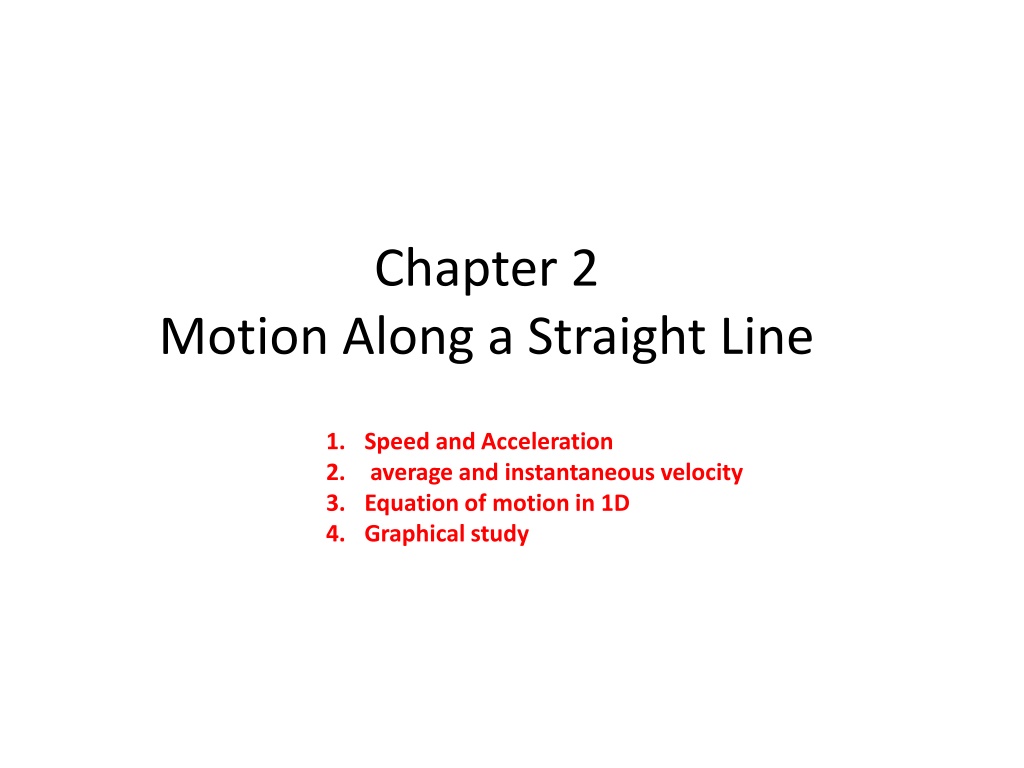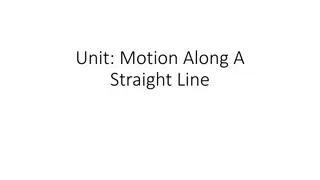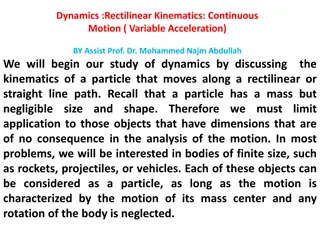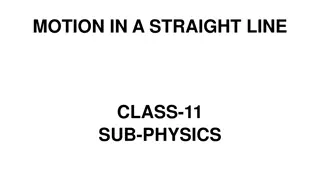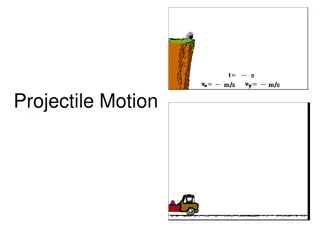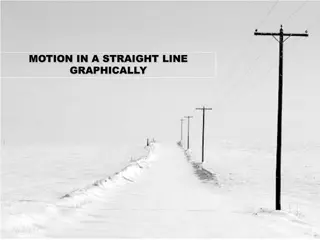Understanding Motion Along a Straight Line
Exploring the concepts of speed, acceleration, velocity, displacement, and distance in one-dimensional motion. Topics include average and instantaneous velocity, equation of motion, graphical analysis, position measurement, and the differences between distance and displacement. Dive into average speed, velocity, and prove concepts with data analysis to understand motion better.
Download Presentation

Please find below an Image/Link to download the presentation.
The content on the website is provided AS IS for your information and personal use only. It may not be sold, licensed, or shared on other websites without obtaining consent from the author. Download presentation by click this link. If you encounter any issues during the download, it is possible that the publisher has removed the file from their server.
E N D
Presentation Transcript
Chapter 2 Motion Along a Straight Line 1. Speed and Acceleration 2. average and instantaneous velocity 3. Equation of motion in 1D 4. Graphical study
Lecture 1 1. Speed and Acceleration 2. average and instantaneous velocity 3. Equation of motion in 1D
Position, Distance and Displacement Position is measured from a starting point called origin (start). Negative Direction (left) Positive Direction (Right) -3 -2 -5 -1 -4 3 0 4 1 5 2 start Displacement: -Length between final and initial position is called displacement Distance: -Total length of the path is distance. 0 3 cm 2cm 5 cm Displacement = (8 cm- 0 cm) = 8cm SI Unit: m Distance = 5cm+ 3cm = 8cm
Distance and Displacement Distance doesn t care about direction of motion (scalar). Displacement cares about the direction of motion (vector). 0 8 cm 2 cm Displacement = (2cm -0 cm )= 2cm Distance = 5cm+ 3cm+6 cm = 14 cm
Average Speed 100 m Total Distance (x) = 20m/s Average Speed (v) = = 5s Total Time (t) SI Unit: m/s t = 0 t = 5 100 m
Average Velocity (vav) xf - xi x Change in Displacement Average velocity (vav ) = = = tf ti t Change in Time SI Unit: m/s ti = 0 tf = 5 xi = 0 xf = 100
Average Velocity (vav) Distance (m) Time (s) Velocity (m/s) Final velocity inital velocity 0 (start) 0 + v v = 0 20 1 20 vav 2 40 2 20 60 3 20 Prove this from the data! 80 4 20 100 5 20 ti = 3 tf = 5 ti = 4 ti = 1 ti = 2 ti = 0 xi = 60 xi =80 xf =100 xi = 20 xi = 40 xi = 0
Instantaneous velocity dx Very small change in Displacement = Instantaneous velocity (v ) = dt Very small change in Time ti = 2.5 2.5s ti = 3 3s ti = 3.5 tf = 5 ti = 4 ti = 0.5 ti = 1 ti = 1.5 ti = 2 ti = 0 ti = 4.5 xi =90 xi = 60 60m xi = 50 50m xi = 70 xi =80 xf =100 xi = 10 xi = 20 xi = 30 xi = 40 xi = 0
0.0625s 0.125s 0.1875s 0.25s 0.3125s 0.375s 0.4375s 0s 0.5s t 0 lim x dx = = v 0 t t dt x 1.25m 2.5m 3.75m 5m 7.5m 7.5m 7.5m 0m 10m
Average Velocity: Data Analysis 60 x x m = = = = 20 / vav m s 3 t t s Distanc e (m) Time (s) Velocit y (m/s) 0 (start) 0 + + 30 10 v v 10 1 10 = = = 0 20 / vav m s 2 2 30 2 20 60 3 30 t = 3s t = 2 ti = 0 t = 1 x = 60 m x = 30 m xi = 0 x = 10 m
Average Velocity: Data Analysis Distanc e (m) Time (s) Velocit y (m/s) 90 x x m = = = = 0 (start) 0 18 / vav m s Common Definition 5 t t s 10 1 10 30 2 20 60 3 30 + + 10 10 v v 80 4 20 = = = 0 10 / vav m s 2 2 90 5 10 This formula is only for continuous change only!
Acceleration (a) Average velocity change per unit time Distance (m) (m) (m) Time (s) Time (s) Time (s) Velocity (m/s) (m/s) Accele ration (m/s2) Distance Distance Velocity vf -vi v v0 Change in velocity = = 5m/s2 = Acceleration (a) = 0 (start) 0 (start) 0 (start) 0 0 0 tf -ti t t0 Change in Time 5 5 5 1 1 1 5 5 5 SI Unit: m/s2 15 15 15 2 2 2 10 10 5 30 30 30 3 3 3 15 15 5 50 50 50 4 4 4 20 20 5 If the velocity change is instantaneous: 75 75 75 5 5 5 25 25 5 2 dv d dx d x = = = ( ) accelerati on a 2 dt dt dt dt t = 5s t = 3 ti = 0 t = 1 t = 3 t = 2 x = 75 m x = 30 m xi = 0 x = 5 x = 50 m x = 15 m
Lecture 2 Graphical study
Basic formulae for the motion + v 0 v x = = vav 2 t Conclusion Conclusion dx v = = = + + dt v v v v a 1at t at 0 0 v v v + = + + 1 2 2 x x v v t = = = 2 0 aav ( ) x t + + a t 0 0 0 = = 2 a a t t t 0 2 2 0 0 2 2 2 2 v v v x x v 2 dv d x = = a 2 dt dt t t0 Take starting point t0 = 0 a x, v x0 , v0
Problem Solving strategy 1. Read the questions carefully and underline the given parameters. 2. Draw picture if possible. 3. Figure out what you need to find. 4. Draw a diagram and write down the given quantities. 5. Write the formula. 6. Solve for the unknown. Example: A car starts from rest and accelerates at a rate of 2.0 m/s2 in a straight line until it reaches a speed of 20 m/s. The car then slows down at a constant rate of 1.0 m/s2 until it stops. How much time elapses (total time) from start to stop? (Ans: 30 s) v0 =20 m/s a = 2.0 m/s2 v = 0 m/s a = -1.0 m/s2 v0 = 0 m/s v = 20 m/s = + v v at 0 Three quantities must be given: Choose first equation. Find two times for two motions Add them up to get answer 1at = + 2 x v t 0 2 a Things to remember: Starts from rest means: v0 = 0 m/s Stopped means: v = 0 m/s Acceleration is negative if final velocity is less and it is called retardation or decelleration = + 2 2 0 2 v v x Choose one equation to find t
Example-1: A car starts from rest and accelerates at a rate of 2.0 m/s2 in a straight line until it reaches a speed of 20 m/s. The car then slows down at a constant rate of 1.0 m/s2 until it stops. (a) How much time elapses (total time) from start to stop? (Ans: 30 s) v0 =20 m/s a = 2.0 m/s2 v = 0 m/s = + v v at a = -1.0 m/s2 0 1at = + 2 x v t v0 = 0 m/s v = 20 m/s 0 2 a = + 2 2 0 2 v v x (b) Find the total distance covered. Choose one equation to find t (c) Find the average speed during the entire motion Example 1-1: A body moves in a straight line with 10 m/s for first 6 seconds. Then it accelerates with 4 m/s2for next 6 seconds. What is the average velocity?
Example 2: The position of a particle x(t) as a function of time (t) is described by equation x(t) = 2.0 + 3.0 t t3 where x is in m and t is in s. (a) At what time the particle reach to maximum positive position? (Ans: 1s) (b) What is the maximum positive position of the particle on the x axis? (Ans: 4.0 m) (c) What is the particle s speed at t = 0.5s ? (d) What is the average speed of the particle from the starting point to the maximum positive position? (e) What is the acceleration of the motion at t = 0.5s ? (f) What is the average acceleration for the entire motion? Example 3-1: A car travels up a hill at a constant speed of 30 km/h and down the same hill at a constant speed of 50 km/h. Calculate the average speed of the car for the round trip (up and down the hill, the same distance). A) 38 km/h Example 3-2: Two automobiles, 150 kilometers apart, are traveling toward each other. One automobile is moving at 60km/h and the other is moving at 40 km/h. In how many hours will they meet? (A: 1.5)
Vertical motion (free fall) Most of the time treat up and down motion separately! = + v v gt v = 0 v0= 0 0 1gt = + 2 y v t 0 2 2 = + 2 2 0 v v gh g =- 9.8 m/s2 g =- 9.8 m/s2 -y y For vertical motion: UP = Positive Down = Negative x = y a = g =- 9.8 m/s2 Dropped (v0 = 0) Maximum Height: (v= 0) upward (v0 = 0) downward v0 -v
Example: Descending -h Velocity = -ve Constant Speed = acceleration = 0
Example: = + v v gt 0 1gt = + 2 y v t 0 2 2 v0 = -2m/s v a = g = -9.8 m/s2 t = 5s y = h = ? = + 2 2 0 v v gh You have 3 quantities given and you can find rest two unknown quantities
Example 4: An object is thrown vertically upward with an initial speed of 25 m/s from the ground. What is the height of the object 1.0 s before it touches ground?(Ans:20 m) Example 5: A ball is dropped from a height of 100 m at t = 0. Later, at t = 1.00 s, a second ball is thrown downward with a speed of 19.8 m/s. At what time will the two balls be at the same height? (Neglect air resistance). (Ans. 1.49 s) Example 6.: Stone A is thrown vertically upward from the ground with an initial speed of 9.8 m/s. After 1 second, stone B is thrown with the same speed vertically upward from the same position. Find the time (in seconds) at which they will be at the same height simultaneously. A) 1.5
Average Velocity (vav): slope of x-t line 100 Distance (m) Time (s) 80 0 (start) 0 x 60 20 1 t x (m) 40 2 40 60 3 20 80 4 100 5 0 2 3 4 5 x dx 1 = = = v slope t (s) t dt ti = 3 tf = 5 ti = 4 ti = 1 ti = 2 ti = 0 xi = 60 xi =80 xf =100 xi = 20 xi = 40 xi = 0
Displacement (x) = Area of x-t Calculate area under the curve and find, x = 100 100 Distance (m) Time (s) Velocity (m/s) 80 0 (start) 0 60 20 1 20 v(m/s) 40 2 20 40 60 3 20 80 4 20 20 100 5 20 0 2 3 4 5 1 x = v t (s) t = . x v t This looks like A = b . l x = area under the v t curve
What if you dont have straight line? Distance Velocity (m/s) Time (s) Time (s) Distance (m) (m) 75 0 (start) 0 (start) 0 0 0 60 5 5 1 1 5 15 15 2 2 10 45 X (m) 30 30 3 3 15 30 50 50 4 4 20 75 75 5 5 25 15 dx v = 0 2 3 4 5 dt vdt = 1 t (s) dx = Calculate velocities at each point dx vdt dx v = Integration = area under the curve dt t Tangent in the curve at a point gives the direction of velocity at the point and the slope of that tangent gives the magnitude of the velocity at that point. t 0 = x vdt = area under the v t curve
Find the velocities in the following diagram v = 2 m/s x =6 v = 0 m/s t =3 v = 1.3m/s x =4 t =3 t(s) x = = v slope t
Acceleration = slope of v-t curve Distance (m) Time (s) Velocity (m/s) Accele ration (m/s2) 25 Distance (m) Time (s) Velocity (m/s) 20 0 (start) 0 (start) 0 0 5 5 1 1 5 5 5 15 v(m/s) 15 15 2 2 10 10 5 10 30 30 3 3 15 15 5 50 50 4 4 20 20 5 5 75 75 5 5 25 25 5 0 2 3 4 5 1 v dv t (s) = = = a slope t dt Calculate acceleration from the slope of the curve
velocity = area under a-t curve Distance (m) Time (s) Velocity (m/s) Accele ration (m/s2) 25 20 0 (start) 0 5 1 5 5 a(m/s2) 15 15 2 10 5 10 30 3 15 5 50 4 20 5 5 75 5 25 5 dv 0 2 3 4 5 1 a = t (s) dt adt dv = Calculate the final velocity v = 25 m/s Integration = area under the curve = dv adt t t 0 = v adt = area under the v t curve
A body start to move from origin in positive x-direction, find the acceleration at different segments. Each unit = 1s Each unit = 10 m/s 0 m/s2 10 m/s2 -10 m/s2 20 m/s2 t = 0 s t(s) 1. From which time period the body moves in positive x direction? 2. At what time body start to slow down? 3. At what time body changed its direction? 4. For which time period body moves in negative x-direction? 5. Which direction particle is moving in last 2 second? 6. Find the average displacement.
Vertical motion (free fall) in graph y t v t a t -9.8 m/s2
Conclusion of a graph Whatever is in the right side of the formula should be given in the graph! x = v v is the slope of x - t curve t = x is the area under the v - t curve x v t v = a a is the slope of v - t curve t = v a t v is the area under the a - t curve Positive Be careful about Negative and Positive Negative Positive Negative
Checkpoint: If initial velocity is zero what is final velocity? t(s) Final velocity (v) = 26 m/s
Example: You need to find v = v a t
Example 7-1: The velocity-time graph of an object moving in a straight line is shown in Figure. (a) Find the total distance covered by the object (b) Find the total distance covered in the first 6.0 s (c) Find the position of the object at t =6 s if it start from 2.0 m from origin. (d)What is the average speed of the object for the first 6.0 s? Ans: 3.3 m/s (e) What is the acceleration of the motion at 4.2 s? (f) Find the average acceleration of the motion. Example 7-2: The graph represents the straight line motion of a car. How far does the car travel between t = 2 s and t = 5 s? Ans: 36 m
4- ideas in this chapter 1. Average Velocity/Speed and Acceleration v vav = t + x 0v v v v = = 0 a 2 t 2. Instantaneous Velocity and Acceleration dx v = Need to know the rules of calculus! 2 dv d x = = a dt 2 dt dt 3. Equation of motion You will always need these equations! = = + + v v v v at gt = = + + = = + + 2 2 2 0 2 0 x h v v t t at gt 2 2 v v v v ax gh 1 0 0 2 1 2 2 0 0 2 4. Reading graph (Slope or Area under the Curve)
T102-Ch2 Q3. A ball is dropped from a height of 100 m at t = 0. Later, at t = 1.00 s, a second ball is thrown downward with a speed of 19.8 m/s. At what time will the two balls be at the same height? (Neglect air resistance). A. 1.49 s 3 Q4. A car starts from rest and accelerates at a constant rate of 2.0 m/s2 in a straight line until it reaches a speed of 30 m/s. The car then slows down at a constant rate of 1.0 m/s2 until it stops. How much time elapses (total time) from start to stop? A. 45 s 1, 3
T102-Ch2 Q5. Which one of the following statements is always FALSE? A) A body has constant velocity and variable acceleration. B) A body has velocity eastward and acceleration eastward. C) A body has velocity eastward and acceleration westward. D) A body has zero instantaneous velocity but non-zero acceleration. E) A body has constant acceleration and variable velocity. 1 Q6. The velocity-time graph of an object moving in a straight line is shown in Figure 1. What is the average speed of the object for the first 6.0 s? Fig# 3.3 m/s 4
T101-Ch2 3 Q4. A particle moves along the x-axis. Its position x as a function of time t is given by: x = 12t 2t2 where x is in meters and t is in seconds. At what time (in seconds) does the particle change its direction of motion? A) 3 2
T101-Ch2 Q5. A ball is dropped from a certain height and bounces back vertically upward after hitting the ground. Figure 1 shows the velocity-time sketch of the ball. Line OA shows the downward motion of the ball and line BC shows the upward motion of the ball (after rebound). The slopes of lines OA and BC must be equal because: 4 A) the acceleration due to gravity remains constant B) the velocity remains the same before and after impact with the ground C) the rebound height is equal to the height from where the ball was dropped D) the speed before and after impact with the ground is not the same E) the velocity changes its direction during impact. Q6. Stone A is thrown vertically upward from the ground with an initial speed of 9.8 m/s. After 1 second, stone B is thrown with the same speed vertically upward from the same position. Find the time (in seconds) at which they will be at the same height simultaneously. A) 1.5 3
T92-Ch2 Q3. An airplane must reach a speed of 400 km/h on a runway for takeoff. What is the lowest constant acceleration (in m/s2) for takeoff from a 2.00 km runway assuming the plane starts from rest? A) 3.09 1,3 Q4. A stone is thrown vertically up from the edge of the top of a 100-m high building. It reaches the ground (at the bottom of the building) after 10.0 s. What is the initial speed of the stone? A) 39.0 m/s 3
T92-Ch2 Q5. A car travels up a hill at a constant speed of 30 km/h and down the same hill at a constant speed of 50 km/h. Calculate the average speed of the car for the round trip (up and down the hill, the same distance). A) 38 km/h 1,3 Q6. Figure 1 shows the acceleration-time graph of a particle moving along an axis. In which of the time intervals indicated in the figure, does the particle move at constant speed? A) a and e 4,3
T91-Ch2 Q3. A hot air balloon carrying a 10.0 kg block is descending vertically at a constant speed of 10.0 m/s. When the balloon is 100 m above the ground, the block is released. How long does it take the block to reach the ground? (Neglect air resistance) A) 3.61 s 3 Q4. Figure 1 shows the velocity-time graph of a particle moving along the x-axis. What is the average acceleration of the particle during the time interval t = 1.0 s to t = 8.0 s? A) -2.1 m/s2 4,3
T91-Ch2 Q5. Which of the graphs shown in Figure 2 represents an object moving with a negative constant velocity? A) 3 1,4 Q6. A car moving along the positive x-axis with constant acceleration covered the distance between two points 60 m apart in 6.0 s. Its velocity as it passes the second point was 15 m/s. What was its velocity at the first point? A) 5.0 m/s 1,3
T82-Ch2 Q3.Two cars A and B travel on a straight line. The displacement of car A is given by xA (t) =2.60 t+1.20 t2, where t is in seconds and xA in m. The displacement of car B is given by xB (t) =2.80 t2- 0.20 t3. At what time the two cars will have the same acceleration? (A 2.67 s) 2 Q4. A ball is thrown from ground straight upward with a velocity of 26 m/s. How long does it take the ball to strike the ground? (Ans: 5.3 s) 3 Q5.Two automobiles, 150 kilometers apart, are traveling toward each other. One automobile is moving at 60km/h and the other is moving at 40 km/h. In how many hours will they meet? (A: 1.5) 1 Q6. The graph shown in Fig.1 represents the straight-line motion of a car. Find its acceleration at t = 6 s. ( A) 3.00 m/s2 4,3
T81-Ch2 Q3.The velocity-time graph of a train traveling in a straight line from station A to station B, 10 km away, is shown in Figure 1. The train starts from A at t = 0 and arrives at B at t = T hours later. Find the acceleration of the train during the first half of the trip. (Ans:1000 km/h2) 4 Q4.: A person throws down a stone into a well with an initial speed of 10 m/s. It takes the stone 3 s to reach the surface of the water in the well. What is the distance traveled by the stone to reach the surface of the water? (Ans: 74.1 m) 3 Q5: The displacement of a car is given by x = 5t2 20t + 10, where x is in meters and t is in seconds. The car was initially moving towards the East. At what time does it change direction and move towards the West? (Ans: 2 s) 2 Q6.: A man leaves his home driving his car for one hour at an average speed of 90 km/h before running out of gas. He then gets out of his car and walks a distance of 10 km in 3 hours before reaching a gas station. The average speed of the man during the whole trip between his home and the gas station is (A) 1 25 km/h
T-72-Ch2 Q2. The position of an object is given as a function of time by x = 4.0t2 3 t3 , where x is in meters and t is in seconds. Its average acceleration during the interval from t = 1.0 s to t = 2.0 s is: (Ans: 19 m/s2) 2 and 1 Q3.: A car starts from rest and undergoes a constant acceleration. It travels 5.0 m in the time interval from t = 0 to t = 1.0 s. Find the displacement of the car during the time interval from t = 1.0 s to t = 2.0 s.( Ans: 15 m) 3 Q4. Fig. 1 represents the velocity of a car (v) moving on a straight line as a function of time (t). Find the acceleration of the car at 6.0 s. (A ns: -3.0 m/s2) 4
T71-Ch2 Q3.Fig 1 shows the position-time graph of an object. What is the average velocity of the object between t=0.0 s and t= 5.0 s? (Ans: 2.0 m/s) 1 and 4 Q4. Fig 2 shows a velocity-time graph of a runner. If the runner starts from the origin, find his position at t = 4.0 s.( Ans: 45 m) 4 Q5.An object is thrown vertically upward with an initial speed of 25 m/s from the ground. What is the height of the object 1.0 s before it touches ground?(Ans:20 m) 3 Q6.: A car starts from rest and accelerates at a rate of 2.0 m/s2 in a straight line until it reaches a speed of 20 m/s. The car then slows down at a constant rate of 1.0 m/s2 until it stops. How much time elapses (total time) from start to stop? (Ans: 30 s) 1
